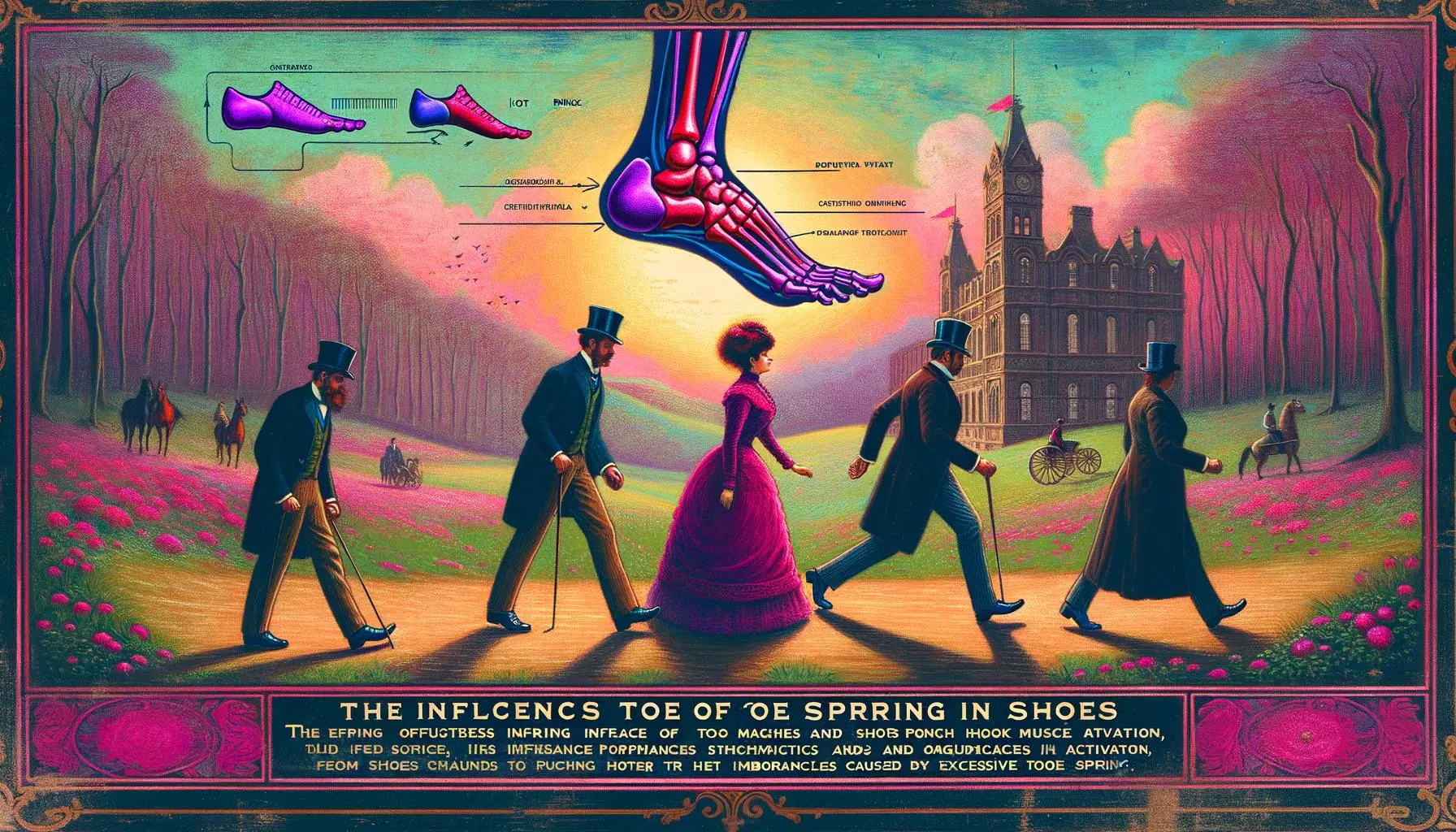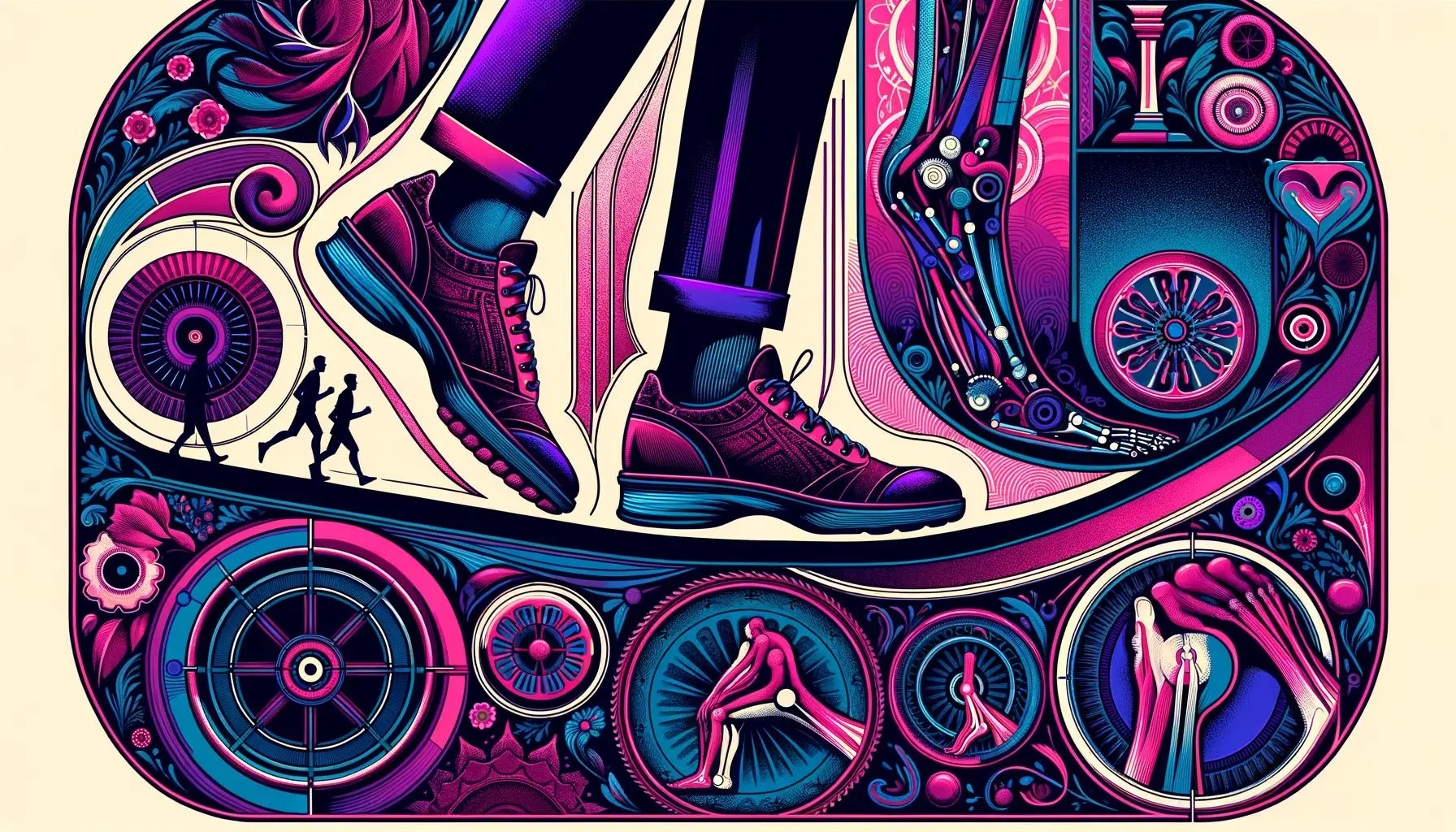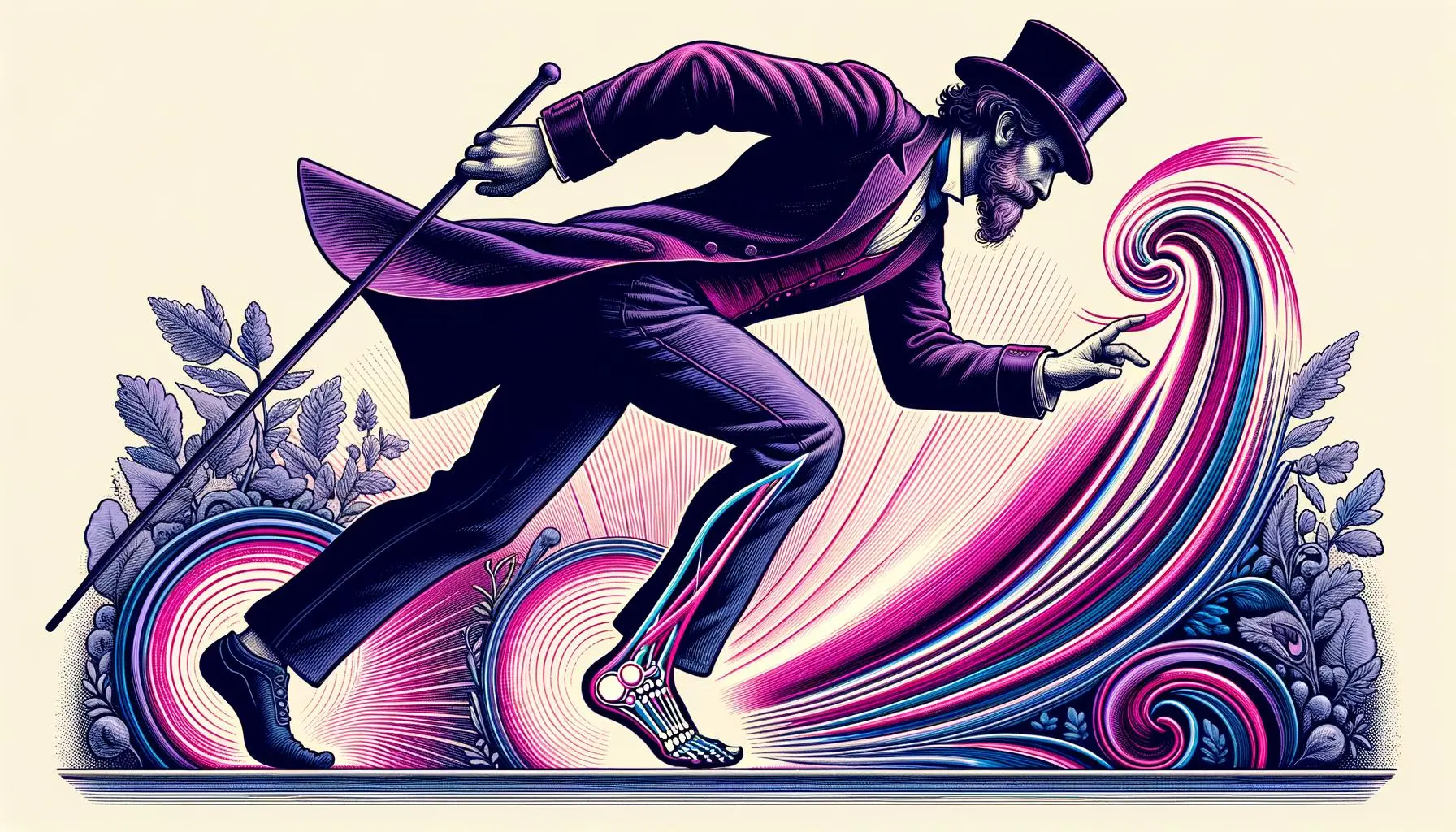· fitness · 14 min read
The Impact of Toe Spring on Foot Health
Explore how toe spring in shoes influences foot biomechanics, muscle activation, and overall foot health through evidenced-based insights.

In This Post
The Fact Why Should I Care How To Put In Action Start Tomorrow Guide How does it effect my ability to focus How does it impact my daily life How does it help me make friends How does it help me manage stress How does it effect my mood Summary: Remember Refresher Checklist The Full Research Article CitationsPrint Out The Tomorrow Checklist!
Sign up for our newsletter and receive a copy today, so that, you can start tomorrow! Or the next day, or the day after that. I forget everything and starting things is hard at least for me so these checklists are godsend.
Print Out The Remember Refresher Checklist!
Sign up for our newsletter and download your own copy of the Remember Refresher Checklist, so that, you can easily put it on your fridge and help you stay on target towards your WHY. Every little bit helps.
Understanding Toe Spring and Its Importance

Introduction to Toe Spring
Toe spring refers to the upward curve from the ball of the foot to the tip of the toe found in many types of footwear. When looking at a shoe from the side, if the toe area points upwards, that’s the toe spring in action. This design isn’t just for aesthetics; it plays a pivotal role in the functionality of shoes, especially in enhancing walking and running efficiency.
Footwear designers incorporate toe spring into shoes for a reason. It’s engineered to complement the natural movement of the feet. As you step, your foot rolls from heel to toe, and a well-designed toe spring facilitates this motion, making each step smoother.
The Role of Toe Spring in Foot Mechanics
The toe spring’s main function is to assist in the ‘roll-off’ phase in the gait cycle – a critical moment when your foot transitions from touching the ground to propelling your step forward. This seemingly minor feature in shoe design significantly contributes to a more efficient walking or running stride. Here’s how:
- Facilitates Natural Foot Movement: By lifting the toes slightly, toe spring reduces the effort needed for the toe-off phase, enabling a more fluid motion.
- Potential Benefits for Foot Health: A proper toe spring can help in reducing the load on certain parts of the foot during motion, potentially minimizing the risk of foot strain and other musculoskeletal issues.
However, it’s crucial to strike a balance. Not all toe springs are made equal, and an excessive curve can lead to muscle imbalances or even foot health complications. Understanding this balance is key to maximizing the benefits while minimizing potential drawbacks.
- [ ] Understand the definition of toe spring and its purpose, in
footwear.
- [ ] Recognize the role of toe spring in facilitating natural foot
movement during the gait cycle.
- [ ] Evaluate the balance of toe spring in shoes to ensure foot health.
In exploring the importance of toe spring, one can appreciate the sophisticated balance footwear designers aim to achieve. It’s not merely about fashion or cushioning; it’s about enhancing the foot’s natural mechanics for better mobility and health. As we delve deeper into the benefits and precautions surrounding toe spring, it becomes clear that the right shoe design can be a cornerstone in maintaining optimal foot function and overall well-being.
The Dual-Edged Sword of Toe Spring: Benefits and Drawbacks

In the realm of footwear design, toe spring is a critical element that can greatly influence foot biomechanics, walking efficiency, and overall foot health. However, like many design features in the footwear industry, it comes with its own set of pros and cons. Understanding these can help in making informed decisions when selecting shoes, ensuring they support rather than harm your foot’s natural movement and balance.
Benefits of Toe Spring
One of the key advantages of incorporating toe spring in shoes is the enhancement of gait efficiency. By slightly elevating the toes, toe spring allows for a smoother transition from heel strike to toe-off during walking or running. This can significantly reduce the effort required for each step, thereby increasing walking efficiency and reducing fatigue.
Moreover, toe spring can play a pivotal role in load distribution across various parts of the foot. By facilitating a more natural roll-off phase, it helps in alleviating excessive pressure on the forefoot and toe joints. This can be particularly beneficial for individuals who spend long hours on their feet or engage in regular running, as it minimizes stress on the foot and contributes to overall foot health.
- Enhances gait efficiency.
- Reduces load on forefoot during motion.
- Supports natural foot mechanics.
- Alleviates pressure on toe joints.
- Minimizes foot strain and fatigue.
Potential Drawbacks and Risks of Excessive Toe Spring
While the benefits of toe spring in footwear are clear, excessive toe spring can lead to a host of issues, underscoring the importance of moderation. One major concern is the risk of muscle imbalances. Shoes with too much toe spring can limit the range of motion essential for healthy foot function, leading to weakening of the foot muscles over time. This imbalance can, in turn, contribute to foot strain and potentially exacerbate conditions like plantar fasciitis.
Another significant drawback involves the potential for long-term foot health implications. Excessively curved shoes may force the foot into an unnatural position, altering normal walking and running mechanics. Over time, this can affect the foot arch and lead to altered load distribution, increasing the risk of injuries and other foot-related problems.
Understanding the balance required in toe spring design is crucial for foot health. Shoes with properly calibrated toe spring can enhance movement efficiency without compromising the foot’s natural biomechanics. Meanwhile, footwear with excessive toe spring poses a risk of inducing muscle imbalances and long-term foot strain, emphasizing the need for careful selection based on individual foot structure and movement patterns.
Examining the Research: What Studies Say

Recent Studies on Toe Spring and Foot Mechanics
The importance of toe spring in footwear design cannot be overstated, especially when it comes to the complex biomechanics of the foot and its effect on gait efficiency. Recent research endeavors have shed light on how varying levels of toe spring influence the mechanics of walking and running, and thus, the overall health and well-being of our feet.
Key studies have focused on how different degrees of toe spring impact muscle activation in the foot, foot arch health, and the distribution of load across the foot during motion. These studies aim to unravel the anatomical impacts of footwear on our foot’s natural ability to absorb shock and support our body weight with each step we take.
One pivotal research concluded that a moderate degree of toe spring can significantly enhance walking efficiency by facilitating a more fluid transition from heel strike to toe-off. This not only reduces the strain on the forefoot but also optimizes the activation of foot muscles, promoting a healthier gait cycle.
However, these benefits are not without their limits. Excessive toe spring, as underscored by several studies, can lead to muscle imbalances, increased foot strain, and a reliance on the shoe rather than the foot’s musculature for propulsion. This condition may predispose individuals to injuries and chronic conditions such as plantar fasciitis.
Insights from these research projects emphasize a need for a balanced approach in footwear design—where the benefits of toe spring are harnessed without compromising the foot’s natural mechanics and muscle activation patterns. This dovetails with the concept of custom orthotics and proper footwear selection, underscoring the idea that one size does not fit all when it comes to the health of our feet.
- Look for shoes that enhance gait efficiency without over-reliance on
toe spring.
- Consider how the design impacts load distribution in the foot,
especially if you have pre-existing conditions.
- Seek footwear that supports rather than hinders muscle activation in
the foot.
- Monitor for signs of muscle imbalances or foot strain, which may
indicate excessive toe spring.
- Consult foot health professionals for advice if unsure about your
footwear's suitability.
The growing body of research on toe spring and foot mechanics serves as a crucial guide for both footwear designers and wearers. It highlights the importance of understanding the subtle ways in which shoe design can impact our health and encourages a more informed approach to footwear selection. This knowledge is not only vital for optimizing our walking and running mechanics but also for maintaining the structural health and balance of our feet over time.
Mitigating the Risks Associated with Toe Spring

When it comes to improving foot health and avoiding potential strain caused by improper footwear, understanding the role of toe spring and how to mitigate its effects is crucial. In this segment, we’ll delve into how to choose footwear with the appropriate level of toe spring, practices to counterbalance its effects, and when it’s time to consult a professional.
Choosing the Right Level of Toe Spring for Your Footwear
Selecting the right level of toe spring in your footwear can significantly influence your walking efficiency, running mechanics, and overall foot health. The objective is to find a balance that supports natural foot biomechanics without causing muscle imbalances or strain. Here are some guidelines:
- Identify Your Foot Type: Different foot arch types may benefit from varying levels of toe spring. Knowing whether you have a high arch, flat foot, or neutral arch can guide your selection process.
- Consider Your Activities: The amount of toe spring that’s beneficial can also depend on whether you’re primarily walking, running, or engaging in specific sports. Tailor your choice according to your most frequent activities.
- Seek Proper Footwear Design: Look for shoes designed with foot health in mind, considering both the anatomical impact of the footwear and its load distribution characteristics.
Exercises and Practices to Counterbalance Toe Spring Effects
Incorporating foot exercises into your routine can help maintain muscle balance and prevent strain. Recommended practices include:
- Toe curls and stretches to enhance flexibility and strength.
- Heel raises to support the Achilles tendon and calf muscles.
- Walking barefoot on different surfaces to encourage natural foot mechanics and muscle activation.
- [ ] Perform toe curls and stretches daily.
- [ ] Include heel raises in your exercise routine 2-3 times a week.
- [ ] Spend some time walking barefoot on soft, natural surfaces each
week.
When to Consult a Professional
Knowing when to seek advice from foot health professionals is vital for preventing long-term issues due to footwear-related muscle imbalances or strains. Indicators include:
- Persistent pain or discomfort in the feet, ankles, or lower legs.
- Noticeable changes in gait efficiency or foot balance during movement.
- Signs of plantar fasciitis or other conditions that may be exacerbated by improper footwear.
If you experience these symptoms, it’s crucial to consult with a professional who can offer customized advice and solutions, such as selecting proper footwear or using custom orthotics for enhanced foot balance.
In conclusion, understanding the importance of toe spring in footwear design and its impact on foot health is just the first step. By carefully selecting shoes with the ideal level of toe spring, integrating foot-strengthening exercises, and consulting professionals when needed, you can ensure that your feet remain healthy, balanced, and well-supported in all your activities.
FAQs on Toe Spring and Foot Mechanics

In our exploration of how toe spring affects foot health, we’ve gathered some of the most frequently asked questions. These inquiries touch on the relationship between toe spring, foot arch health, the potential exacerbation of plantar fasciitis, and recommendations for footwear brands that optimize toe spring for health.
How Does Toe Spring Affect Foot Arch?
Toe spring, by design, influences the natural mechanics of your foot. Specifically, it impacts the foot arch by:
- Supporting the natural roll-off of your foot from heel to toe during walking or running.
- Potentially reducing strain on the arch by facilitating a smoother transition in foot movement.
However, it’s crucial to find the right balance. Too much toe spring can lead to inadequate arch support, stressing the plantar fascia and potentially leading to conditions like plantar fasciitis.
Can Toe Spring Cause or Worsen Plantar Fasciitis?
Yes, excessive toe spring in footwear can contribute to or exacerbate plantar fasciitis by:
- Overstretching the plantar fascia, the thick band of tissue that supports the arch of your foot.
- Creating muscle imbalances and increasing foot strain, especially if the footwear lacks adequate arch support.
To mitigate these risks, selecting shoes with a moderate toe spring and ensuring proper arch support is essential.
Are There Specific Footwear Brands That Optimize Toe Spring for Health?
While many footwear brands consider the biomechanical effects of toe spring in their designs, here are a few tips for finding the right shoe:
- Look for brands that emphasize foot health in their design principles.
- Consider shoes endorsed by foot health professionals, such as
podiatrists.
- Check for features like adjustable toe spring levels or models designed
for specific activities.
Selecting the right shoe can make a significant difference in promoting foot health, improving walking and running mechanics, and preventing foot strain. While specific brands may not be mentioned here, it’s crucial to focus on the shoe’s features and how well they accommodate your unique foot biomechanics.
Through understanding the implications of toe spring on foot mechanics, including its effect on the foot arch and its potential to cause or worsen plantar fasciitis, individuals can make informed decisions about their footwear. Always consider the balance between toe spring and foot arch support to maintain optimal foot health and function.
Conclusion - Embracing Balance in Foot Health

As we conclude our exploration of toe spring and its impact on foot health, it’s imperative to remember the core message: understanding and selecting the right level of toe spring in your footwear is vital for promoting foot health and preventing strain. To synthesize the insights we’ve garnered throughout this discussion, let’s recap the vital points.
Toe spring, the upward curve at the front of your shoes, plays a significant role in aiding the roll-off phase during walking or running. This design element can enhance walking efficiency and reduce the load on certain parts of the foot, contributing to a smoother gait. However, not all toe springs are created equal. Excessive toe spring can lead to muscle imbalances, foot strain, and potentially long-term foot health issues.
Balancing the benefits and drawbacks of toe spring requires informed footwear selection. Always opt for shoes that align with your foot’s natural mechanics and address your specific needs, whether for daily activities or specialized sports. Moreover, incorporating foot exercises into your routine can counterbalance the effects of toe spring, promoting muscle activation and foot stability.
- [ ] Choose footwear with an appropriate level of toe spring for your
activities.
- [ ] Regularly perform foot exercises to enhance foot muscle strength
and flexibility.
- [ ] Be mindful of any signs of foot strain or imbalance; consult a foot
health professional if necessary.
Remember, the goal is not to eliminate the use of toe spring entirely but to find a harmonious balance that supports your foot’s biomechanics and overall health. By making informed choices and remaining vigilant about our foot health, we can enjoy the benefits of modern footwear design without compromising on comfort or wellness.
In closing, let’s embrace the diversity in our footwear needs and continue to seek knowledge and professional advice to ensure our feet remain healthy, supportive, and prepared for every step of our journey.
3 Relevant Links - Toe Spring and Foot Health

In navigating the intricate relationship between toe spring and foot health, it’s crucial to have access to reliable resources for informed decisions and further learning. Below, we highlight three noteworthy links that dive deeper into foot mechanics, the benefits of custom orthotics, and professional advice on foot health. These resources can act as useful guides for both seasoned athletes and everyday shoe wearers looking to optimize their foot health and walking efficiency.
Foot Health Professional Advice - The American Podiatric Medical Association (APMA) offers a plethora of information regarding foot health, providing insights into the proper care and attention your feet deserve. For anyone looking to understand more about the anatomical impact of footwear and seeking professional guidance, the APMA is a great starting point.
Understanding Foot Mechanics - This informative article by Harvard Medical School delves into the biomechanics of foot movement, an essential read for anyone interested in how our feet interact with different types of footwear, including those with varying degrees of toe spring.
Benefits of Custom Orthotics for Foot Balance - The Orthotic Group provides a comprehensive look at how custom orthotics can aid in achieving foot balance, mitigating muscle imbalances, and addressing foot strain. This resource is particularly beneficial for individuals experiencing discomfort or looking to prevent potential foot problems.
To help ensure that you’re making the best choices for your foot health when it comes to toe spring and footwear, here’s a quick checklist to keep in mind:
- [ ] Investigate the degree of toe spring in your current footwear.
- [ ] Assess any current foot problems or discomforts you might be
experiencing.
- [ ] Seek professional advice for persistent foot issues.
- [ ] Consider custom orthotics if standard footwear doesn't meet your
needs.
- [ ] Stay informed on the latest research and recommendations in foot
biomechanics.
By tapping into these resources and keeping this checklist in mind, you can better navigate the complexities of toe spring and its impact on foot health. Remember, the goal is to find a balance that supports your foot’s natural mechanics, promotes gait efficiency, and, most importantly, keeps you moving comfortably in all walks of life.





